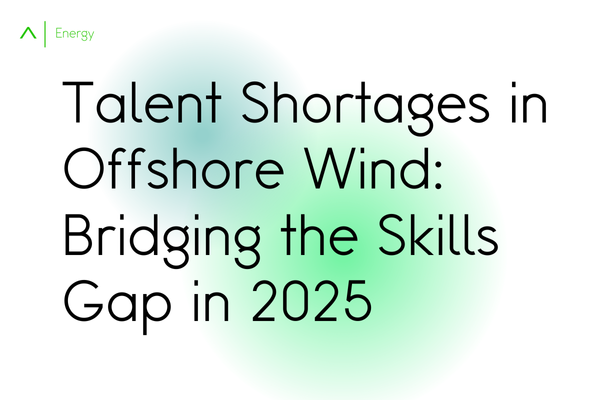Talent Shortages in Offshore Wind: Bridging the Skills Gap
27 Mar, 20254 minsAs the offshore wind industry experiences unprecedented growth in 2025, a significant challe...

As the offshore wind industry experiences unprecedented growth in 2025, a significant challenge has emerged that threatens to slow this momentum: a deepening shortage of skilled professionals. With ambitious targets set globally for renewable energy deployment, the talent gap in offshore wind has become one of the sector's most pressing concerns.
The Scale of the Challenge
Recent industry reports paint a concerning picture. According to the Global Wind Workforce Outlook released in late 2024, the wind sector is projected to face a 6-8% global shortage of skilled wind technicians by 2028. The industry will need over 532,000 technicians to build and maintain global onshore and offshore wind fleets, with 40% of these roles needing to be filled by new entrants.
In the UK alone, the number of people working in direct and indirect jobs in offshore wind is set to rise from 26,000 to 69,000 by 2026, driven by £60.8 billion of private sector investment. This rapid expansion will require a highly skilled workforce that currently doesn't exist in sufficient numbers.
Most In-Demand Roles in 2025
As we progress through 2025, several key job categories are experiencing particularly acute shortages:
Technical Specialists
- High-Voltage Electrical Engineers and Technicians: Professionals with experience in the design, manufacturing, and installation of turbine components, high-voltage cables, and substations are in extremely high demand.
- Senior Authorised Persons (SAPs): These professionals oversee safety for standard and specialised high-voltage tasks in both onshore and offshore maintenance.
- Fabrication and Welding Specialists: Particularly critical for the floating offshore wind sector, which requires large numbers of skilled welders.
Digital Specialists
- Data Analysts and AI Specialists: Skills in data analytics, artificial intelligence, and machine learning are increasingly valuable for operational efficiency.
- SCADA and CMS Specialists: Professionals who can analyse and manage Supervisory Control and Data Acquisition and Construction Monitoring System data.
- Digital Twin Engineers: As digital twin technology becomes more widely adopted for operations and maintenance, software developers who can integrate these systems are highly sought after.
Project Management
- Experienced Project Managers: Professionals capable of managing large-scale projects (300MW+ in some European countries) involving multiple contractors are in particularly short supply.
- Consenting and Planning Specialists: Expertise in environmental impact assessments, stakeholder management, and navigating regulatory frameworks remains critical.
Operations and Maintenance
- According to industry studies, O&M consistently makes up the largest share of new jobs each year, with significant growth projected through 2025 and beyond.
Strategies for Addressing the Skills Gap
As the industry grapples with these shortages in 2025, several strategies are proving effective:
1. Transitioning Talent from Adjacent Sectors
The oil and gas sector presents a significant opportunity for skills transfer. With a 60% skills overlap between offshore oil and gas and floating offshore wind, professionals from traditional energy sectors are increasingly making the transition. However, challenges remain in areas such as:
- Salary expectations: Bridging the gap between traditional and renewable energy compensation structures
- Cultural differences: Adapting to the innovation-focused culture of wind energy
- Competency requirements: Addressing the "offshore wind competence" barrier that can hinder those with transferable skills but limited wind-specific experience
2. Specialised Training Programs
Companies are increasingly investing in targeted training initiatives:
- GWO-Certified Training: Standardised Global Wind Organisation training ensures consistent safety and technical skills.
- Rapid Upskilling Programs: Short-term, intensive courses focused on converting existing technical skills to wind-specific applications.
- Regional Training Clusters: Development of specialised training centres in key offshore wind development regions.
3. Educational Partnerships
Long-term solutions are being built through collaboration:
- University Partnerships: Development of specialised offshore wind engineering degrees and research programs.
- STEM Focus: Enhanced emphasis on science, technology, engineering, and mathematics education with wind energy applications.
- Apprenticeship Expansion: The demand for UK offshore wind apprenticeships has grown significantly, with approximately 300 new positions annually.
4. Diversity and Inclusion Initiatives
Expanding the talent pool through greater inclusion:
- Gender Balance: Working toward the UK Offshore Wind Sector Deal aim of increasing female representation to 33% by 2030.
- Ethnic Diversity: Targeting increased BAME representation (9% by 2030) through targeted recruitment and mentoring.
- Cross-Sector Attraction: Drawing talent from adjacent industries through focused recruitment campaigns highlighting transferable skills.
Case Study: Innovative Approaches in 2025
Empire Engineering, a specialised offshore wind consultancy, has implemented a successful talent strategy that serves as an industry model in 2025. Their approach combines:
- Targeted Skills Development: Focusing on critical areas including geotechnical engineering, transport and installation, fabrication management, and advanced simulation software.
- Early Career Engagement: Collaborating with universities to identify promising candidates before graduation and providing specialised training.
- Cross-Sector Recruitment: Actively recruiting from related industries and providing transition pathways, particularly for professionals with experience in:
- Advanced ANSYS/SESAM/Orcaflex modelling
- Primary and secondary steel fabrication
- Offshore project engineering
Future-Proofing the Workforce
Looking beyond immediate shortages, industry leaders are implementing strategies to build resilience into the talent pipeline:
1. Digital Transformation
Investing in automation, robotics, and AI to optimise workforce deployment and reduce reliance on hard-to-fill positions. This includes:
- Remote monitoring systems that reduce the need for offshore technicians
- Drone and robotic inspection technologies
- Predictive maintenance systems that optimise workforce scheduling
2. Standardisation Efforts
Working to standardise designs, components, and processes across the industry, reducing specialised skills requirements and enabling more efficient training programs.
3. Government Collaboration
Engaging with policymakers to develop:
- National workforce development strategies
- Funding for specialised training programs
- Educational curricula aligned with industry needs
- Initiatives to facilitate worker transition from carbon-intensive industries
Meeting the Challenge
The talent shortage in offshore wind represents both a significant challenge and a tremendous opportunity. With global renewable energy targets demanding rapid expansion, innovative approaches to workforce development are essential.
Success will require unprecedented collaboration between industry, government, and educational institutions, along with significant investment in training and development programs. Companies that take a proactive, strategic approach to talent acquisition and development will be best positioned to thrive in this rapidly evolving sector.
As we progress through 2025, addressing the skills gap in offshore wind isn't just about meeting immediate staffing needs—it's about building the foundation for a sustainable energy transition that will shape our energy landscape for decades to come.


